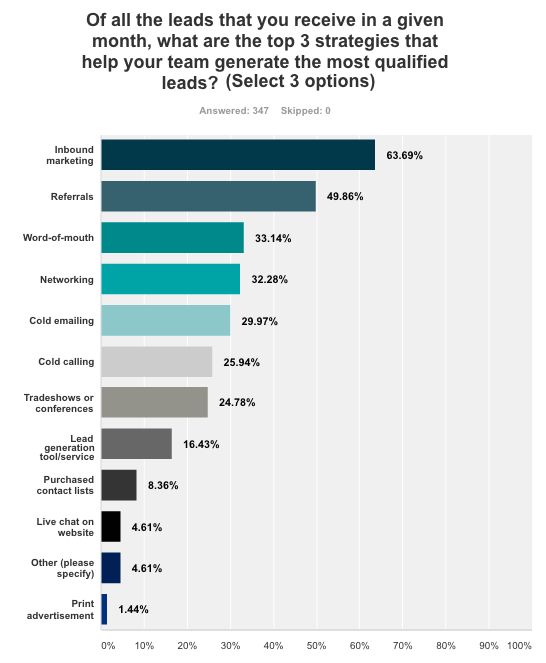October 12, 2016 // 8:30 AM (Original post date)
Written by Pete Caputa | @pc4media
Dear salespeople,
High-volume email sales prospecting is an arms race you're not going to win. Stop doing it.
Regards,
Pete
It all began with mail merge -- a seemingly harmless way to more efficiently send direct mail. But then the technique moved to email and has become a plague on all our inboxes, especially buyers’. Today, there seems to be a new automated email prospecting tool popping up every month. These software programs make it easy to steal or guess email addresses, then send a series of emails in just a matter of clicks.
But prospects have had enough of the spammy email messages they're getting from salespeople. Don't believe me? Try reading the comments on my most popular post on this blog: "Salespeople, Please Stop Sending Terrible Prospecting Emails Like This."
Also consider this: If you're sending loads of emails that aren't garnering a response from most of your prospects, you’re literally biting the hand that feeds you.
Not ready to stop? You might not have an option at some point. Prospects are so pissed off, they're fighting back. And in this fight, I'd bet on them any day of the week. Email sales prospecting is an arms race you're not going to win. Just as you find more ways to send spam, buyers will find easier ways to ignore your emails. Like democracy trumped communism, buyers will defeat salespeople in this cold war.
4 Ways Buyers Are Already Ignoring Your Emails
1) They’re relying on email less.
"We use Slack for our company's internal coordination instead of email now. One of its many benefits is that we get distracted by unsolicited sales emails a lot less frequently," says Chris Handy, founder of Thinkhandy Marketing.
I did much of the research for this post in a Slack group, including soliciting that quote from Handy. Organizations using Slack are collaborating in real time with colleagues in an environment unpolluted by unsolicited sales emails. As companies rely on email less frequently, your buyer will be less likely to even see your email, let alone bother to respond to it.
2) They're using software to route your messages out of their inbox.
"SaneBox has truly cleaned up my inbox," says Joe Jerome, founder of BrandBuilders. "On a typical day, I’d come into the office with about 60 to 100 unread emails. SaneBox learned which emails are important to me by observing which emails I acted upon. I also trained it by setting up some filters. Now, I have only 15 to 20 unread emails per day, all of which are high priority."
Tools like SaneBox and even Gmail itself are making it easy for users to sort important messages from unwanted ones. I’d be willing to wager that email service providers will eventually solve this problem for buyers, once and for all.
3) They use a separate email alias for web forms.
Gmail has a feature that allows users to create aliases automatically. Users just have to add a "+" and anything else after their email alias and before the "@" sign. For example, years ago, I started using the alias myemail+blogsubs@gmail.com to sign up for subscriptions. Then, I set up a filter to route those messages into another folder.
Some buyers go a step further and set up an entirely separate account or alias to use in website forms. This prevents salespeople from simply removing the text after the "+" and sending sales and marketing messages straight to a prospect’s inbox anyway.
4) They filter messages containing commonly used sales phrases.
Are your prospecting messages predictably scripted? Jason Diller, director of marketing for The DSM Group, created a filter using common phrases found in typical sales emails.
For example, any email that includes a phrase like "companies like yours" or "time for a demo” gets automatically routed to his archive folder with a "salesperson" label on it.
7 Tips to Connect With Email-Prospecting-Proof Prospects
Because more prospects are blocking your messages, your normal email prospecting habits are probably getting you diminishing returns. What should you do instead? Try these seven tips:
1) Build real relationships.
People who like and respect you will take your phone calls and answer your emails. Their SaneBox won’t auto-sort you into an archive folder.
Now that I've been in the workforce for over 20 years, I truly understand the importance of building genuine two-way relationships based on trust and mutual benefit. There are hundreds of people I could call right now to ask for a favor, a referral or to help me directly with my next project. But it doesn't take 20 years to build your network. If you're new in sales, start now. Help people when you have the chance to do so. They'll remember you fondly and will always take your call.
2) Attract prospects to you by publishing valuable content.
Maybe you’re not a writer. Managing the website and publishing blog content is probably not your responsibility.
Well, make it your responsibility. Or stand up on your desk and demand more from your marketing team. Publishing content that attracts and educates your target buyers is one of the smartest things you can do to improve your connect rate. You’d be amazed at the number of messages I get after publishing just one blog post. HubSpot generates tens of thousands of leads per month because we’ve been committed to blogging for a decade now.
Don’t take my word for it, though. A few hundred salespeople we surveyed who work at our customers’ companies report that inbound marketing is their best source of leads, even better than referrals and word of mouth.

3) Use a wide variety of touchpoints to connect.
Don't rely exclusively on email prospecting. As it gets harder to make it through to buyer's inboxes, salespeople need to get better at efficiently using other methods for connecting. Get better at networking (both online and in real life), attend events, and build up your social following. You can even start your own Slack group and invite your buyers to join it.
Also, get more comfortable making prospecting calls. Too many salespeople rely on email prospecting to schedule every one of their phone calls. But picking up the phone and calling someone still works if you do it enough and do it right. You might face resistance from buyers when they answer, but with practice, you will avoid and handle the resistance better.
(Want more? Here's 45 prospecting tips from some of my favorite experts.)
4) Stop pitching over email.
Too many salespeople prematurely pitch over email. They describe the features and benefits of their products and services, what they do and how they do it. As should be evident by the low response rate these types of emails get, their pitch is falling on deaf ears.
What should you do instead? Determine whether a prospect has a need before pitching anything.
In your first emails to a new prospect, try keeping your messages short and about your buyer. Here's 28 approaches I've tested that don't include phrases like "When can we schedule a demo?"
5) Pay attention to the clues your prospects leave you.
Too many salespeople start their day by sending unsolicited emails to unsuspecting prospects. Even worse, these emails are often irrelevant to the buyer given their situation and priorities.
It just doesn’t work.
Instead, pay attention to the clues prospects are leaving. Read the company and product announcements they publish, blog posts they share and updates they make on social media sites. If you have prospects visiting your website, determine their interests based on what pages they view.
All of this is pretty easy with the right software. If you're not using tools that help you track your prospect's activity on your website or monitoring buying signs on social sites, you need to start. Instead of cold emailing, spend your day responding to clues.
6) Make yourself available when prospects want to talk to you.
Salespeople are usually pretty responsive when a prospect emails or calls. But, since most buyers check out vendor websites long before they decide to reach out to salespeople, smart salespeople are prompting conversations earlier in the buying cycle by making it easier for a buyer to connect to them immediately. Here are a few ways you can do this:
- Implement live chat on your website so that buyers can initiate a dialog when they're visiting it.
- Also, make it easy for them to self-schedule time on your calendar by making it publicly available to them.
The moral of the story? When a buyer wants to talk to you, be available.
7) Constantly improve your emails.
I’m amazed that salespeople send the same message over and over. Sometimes to the same prospect. From one salesperson, I literally received the same message from them every few weeks for 12 months.
While timing and persistence is important, so is constant improvement.
Experiment with different messages. Measure which messages get the best results and use them more frequently. Once you find a few that work, use those. But, don’t stop tweaking and trying new ones.
If you run out of ideas, ask for feedback and coaching from your peers or your manager. Invite colleagues to critique your emails, and ask them to share their best-performing ones too.
To Start Being Worthy of Attention, Stop Fighting For It
The internet, email, social networks, and sales and marketing software have given salespeople the ability to sell to more buyers more efficiently than ever before.
But for some reason, salespeople always seem to push the envelope too far, as if sales is some sort of warfare. Unsolicited, uncustomized, high-volume, cold email prospecting is a prime example of an activity that you need to stop.
I’m flabbergasted by the number of salespeople abusing email, when a better path is so readily available. It has never been easier to be immediately helpful to prospects because of the data available to us about buyers, the ability for them to learn about us through our online presence and the tools we have to track their behavior.
If you want, you can start doing better immediately. It’s not that hard. Before reaching out to your next prospect, do some research to learn about them as an individual and what’s unique about their company, then tailor your approach. Share opportunities for improvement that fit their individual context. Offer them assistance. Then, be ready to help when they want it. Not only is this approach better for the buyer, you’ll find that buyers respect you more because you don’t seem so desperate to sell your solution.
Need help designing a better prospecting and selling process for your company? Enroll in HubSpot’s free, on-demand sales training program to craft prospecting messages that get responses.





